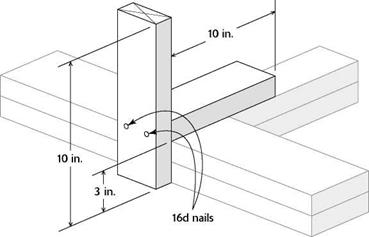STEP 4 MARK THE PLATES
Building walls is like baking a cake. Success depends on having all the right ingredients. When you mark the plates, you’re setting the exact locations for all of the headers, cripples, studs, corners, and wall intersections associated with each wall in the house.




Mark corners and channels first
When marking up each plate, start with the locations of corners and wall intersections, which are referred to as channels or tees (see the top illustration at right). As we’ll see shortly, corners and channels require extra studs so that the walls can be properly nailed together once they are raised. The extra studs also provide backing for drywall on the inside and siding on the outside. Use a channel marker to mark corners and channels on the plates. Store-bought aluminum markers are available, as shown in the left photo on p. 90. It’s also easy to make your own (see the bottom illustration at right).
Take time to make accurate layout marks. Sloppy work at this stage means trouble after the walls have been raised and you begin to plumb and straighten them. Draw accurate lines along all edges of the marker, including the inside edges of the plates, where one wall intersects another. In other words, mark the inside, the outside, and the top surfaces of the through – wall plate. This is important. These corner and channel marks also indicate where the double top (or cap) plates will intersect, tying together through walls and butt walls. Use a keel to mark an “X” on the top plate to let the wall – builder know the location of a corner or channel. Some carpenters write out the word “tee” to note the location of an intersecting channel.
Keep layout marks clean and simple
Methods of marking header locations on plates differ regionally. Whichever system you use, keep it simple. Check the floor plans for each header location, then position the header on the top plate, aligning the sides of the header with the edges of the plate. Mark down from both ends of the header, across both the top and the bottom plates. On outside walls, make these marks on the outside; on interior walls, make marks on the stud layout side.
Next to the end line, mark an “X” on both plates on the side away from the header to indicate the king-stud location (see the photo on p. 91). King studs are nailed alongside headers
Be sure to mark the inside, top, and outside of every through-wall plate with the locations of every intersecting wall, both channels and corners.
|
|
||







Leave a reply